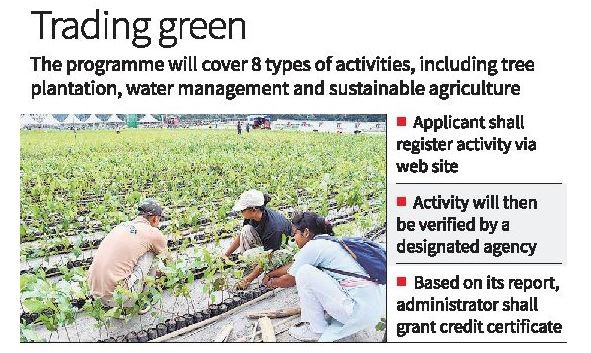Description

Disclaimer: Copyright infringement not intended.
Context
- The Ministry of Environment, Forest and Climate Change (MoEFCC) has recently issued the Green Credit Rules 2023, which formally established the Green Credit Programme (GCP) for India.
Green Credit Initiative of India
- The Green Credit Initiative was launched by the Indian PM on the sidelines of COP 28.
- Union budget 2024 had also highlighted the Green Credit Initiative.

- Lifestyle for Environment (LiFE) movement is the parent initiative under which it was started.
- The concept of LiFE was introduced by the Indian PM Narendra Modi at COP26 in 2021, to drive international communities towards “mindful and deliberate utilization” to protect and preserve the environment.
- Its main objective is to establish a mechanism where participants could earn incentives in the form of ‘Green Credits’.
- The proposed GCP will be implemented in phases, with the initial phase focusing on water management and afforestation.
- The GCP introduces a market-based approach to incentivize various identified environmental activities.

Activities covered
Eight activities have been covered under the program
- Tree Plantation: Planting trees to increase green cover and combat deforestation.
- Water Management: Implementing strategies to efficiently manage and conserve water resources.
- Sustainable Agriculture: Promoting eco-friendly and sustainable agricultural practices.
- Mangrove Conservation and Restoration: Protecting and restoring mangrove ecosystems for ecological balance.
- Waste Management: Implementing effective waste management systems to reduce environmental pollution.
- Air Pollution Reduction: Initiatives aimed at reducing air pollution and improving air quality.

Implementation of the Project
- Under the Green Credit Program, registered and approved entities can pay to finance afforestation projects in specific tracts of degraded forest and wasteland.
- Two years after planting and an evaluation by the International Council of Forestry Research and Education (ICFRE), each planted tree could be worth one ‘green credit’.
- According to the reports, 10 States have identified parcels of degraded forest land, amounting to about 3,853 hectares.
- Chhattisgarh and MP together account for up to 40% of the forest land made available.
|
What is a Carbon Credit?
●Carbon offsetting is a carbon trading mechanism that allows entities such as governments or businesses to compensate for their greenhouse gas emissions. It works by supporting projects that reduce, avoid, or remove emissions elsewhere.
●One credit allows for the emission of one tonne of CO2 or the equivalent of other greenhouse gases.
●The carbon credit is one component of a "cap-and-trade" program. Polluters are given credits that allow them to continue polluting up to a certain limit. This limit is reduced regularly. In the meantime, the company may sell any unsold credits to another company that requires them.
|
Source: https://www.thehindu.com/news/cities/Visakhapatnam/venomous-jellyfish-blooms-spotted-along-visakhapatnam-coast-in-andhra-pradesh/article68023846.ece
|
PRACTICE QUESTION
Q. Consider the following statements about the “carbon credits”
- The carbon credit system was ratified in conjunction with the Kyoto Protocol
- Carbon credits are awarded to countries or groups that have reduced greenhouse gases below their emission quota
- The goal of the carbon credit system is to limit the increase of carbon dioxide emission
- Carbon credits are traded at a price fixed from time to time by the United Nations Environment Programme.
Which one of the above following statements is not correct?
Answer- D
|














